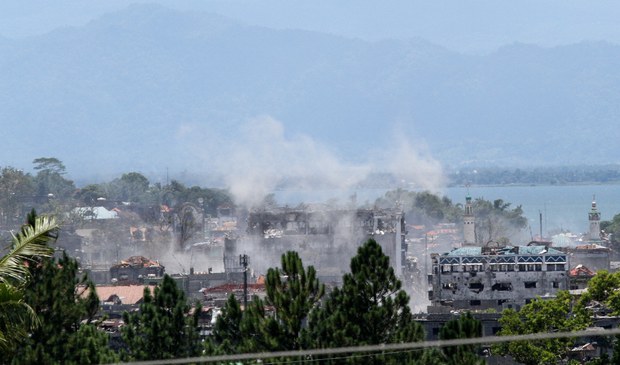Philippine Defense Chief Endorses End to Martial Law in Mindanao
2019.12.05
Iligan, Philippines
 A section of the southern Philippine city of Marawi burns during a battle between government troops and Islamic State-lined militants, Aug. 30, 2017.
A section of the southern Philippine city of Marawi burns during a battle between government troops and Islamic State-lined militants, Aug. 30, 2017.
Philippine Defense Secretary Delfin Lorenzana is recommending that martial law in the south be lifted by year’s end, saying that military rule there is no longer necessary.
Martial law across Mindanao island and the country’s southern third has been in force for two and a half years, through multiple extensions, but is set to expire Dec. 31.
It was first imposed by a presidential order from Philippine leader Rodrigo Duterte in May 2017 to counter Islamic State-linked militants who then took over Marawi, a city in the south, and would hold on to it for five months as they battled government forces.
“Our security forces have determined that the purpose of implementing martial law has been attained and prevailing conditions in the whole of Mindanao island as well as the islands of Basilan, Sulu and Tawi-Tawi have greatly improved since the defeat of the Maute fighters in October 2017,” Lorenzana said in a statement issued Wednesday.
Named after the brothers Maute, the militant group provided the main back-up force for Abu Sayyaf leader Isnilon Hapilon, when he led hundreds of fighters from Southeast Asia and the Middle East in the siege of Marawi.
Both the military and police have made similar assessments that military rule was no longer needed in the south, and Lorenzana said he had endorsed the recommendation for signing by the president.
Hapilon, the Islamic State (IS) leader in the southern Philippines, and his fighters assassinated Christians and took dozens of civilians hostages when they took over Marawi city. His fighters engaged the Philippine military in deadly urban warfare, which at first stumped government soldiers who were more adept at jungle fighting.
American and Australian forces later assisted the Philippine military in non-combat roles in its campaign to break the IS siege of the city. They provided valuable intelligence data that helped pinpoint enemy targets in and around Marawi.
The militant fighters were eventually routed, with Hapilon among the dead. However, many militants, with foreigner fighters possibly among them, managed to flee the devastated city and resume recruitment operations in the Philippine south, officials said.
Hapilon has since been replaced as the IS regional leader by Hatib Hajan Sawadjaan, a little-known Abu Sayyaf commander based on Jolo island. He has been blamed for masterminding suicide bombings there this year.
The deadliest attack was in January, when Sawadjaan deployed an Indonesian couple to detonate two suicide vests at a church in Jolo, killing 23 people.
Lorenzana as well as top military and police officials have said that there were dozens of foreign fighters lingering in the region.
In his statement, Lorenzana said that “threat groups” were no longer able to carry out “a Marawi-type attack” in the south because their forces had been significantly downgraded.
The Philippine congress had approved two extensions of military rule and the suspension of the writ of the privilege of habeas corpus in the south. However, violent attacks still happened in Mindanao in recent months despite the declaration of martial law.
Mark Navales in Cotabato, Philippines, contributed to this report.







